Abstract
Using breath hydrogen analysis after 139 mmol (50 g) oral lactose load, we investigated the prevalence of lactose malabsorption in 200 Greek adults and examined the relationship between symptoms and small bowel transit time. One hundred and fifty subjects had increased breath hydrogen concentrations (greater than 20 ppm) after the lactose load. In these individuals peak breath hydrogen concentration was inversely related to small bowel transit time (r = 0.63, 6 = 6.854, p less than 0.001) and the severity of symptoms decreased with increasing small bowel transit time. Lactose malabsorbers with diarrhoea during the lactose tolerance test had a small bowel transit time of 51 +/- 22 minutes (x +/- SD; n = 90) which was significantly shorter than the small bowel transit time of patients with colicky pain, flatulence, and abdominal distension (74 +/- 30, n = 53; p less than 0.001) and both groups had significantly shorter small bowel transit time than that of asymptomatic malabsorbers (115 +/- 21 n:7; p less than 0.001). When the oral lactose load was reduced to 33 mmol (12 g), the small bowel transit time increased five-fold and the overall incidence of diarrhoea and/or symptoms decreased dramatically. These results indicate that the prevalence of lactase deficiency in Greece may be as high as 75% and suggest that symptom production in lactose malabsorbers is brought about by the rapid passage down the small intestine of the malabsorbed lactose.
Full text
PDF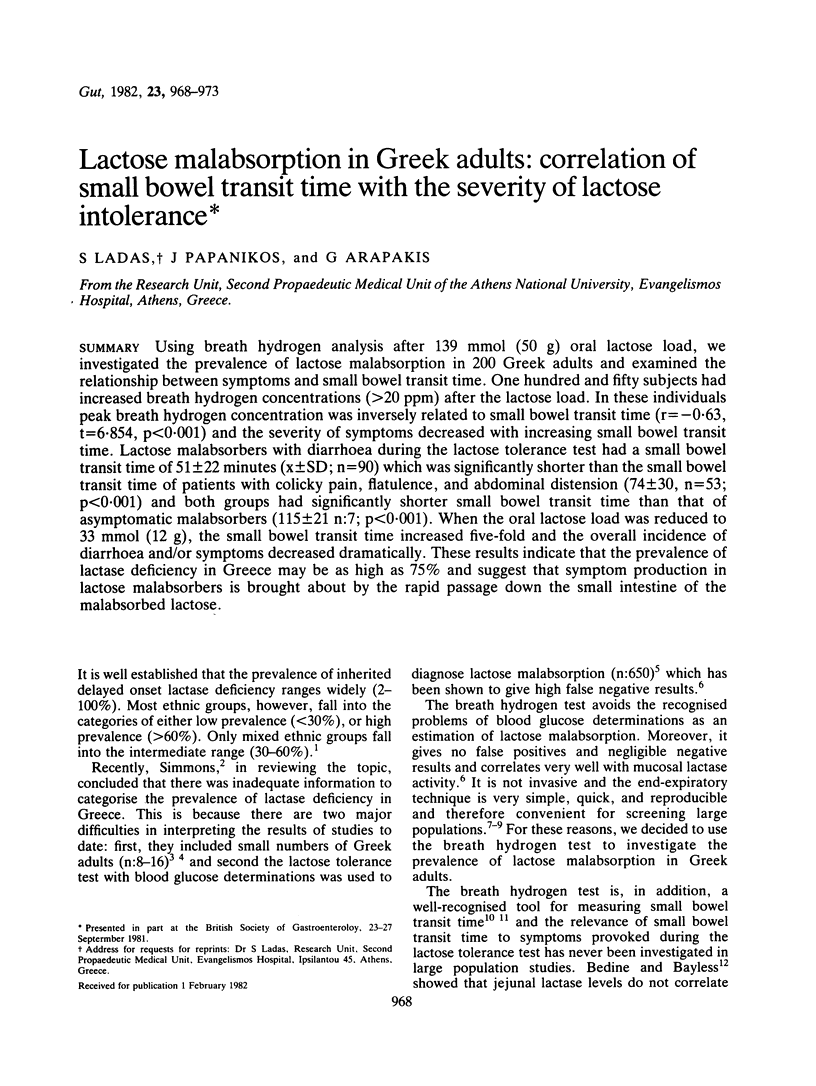
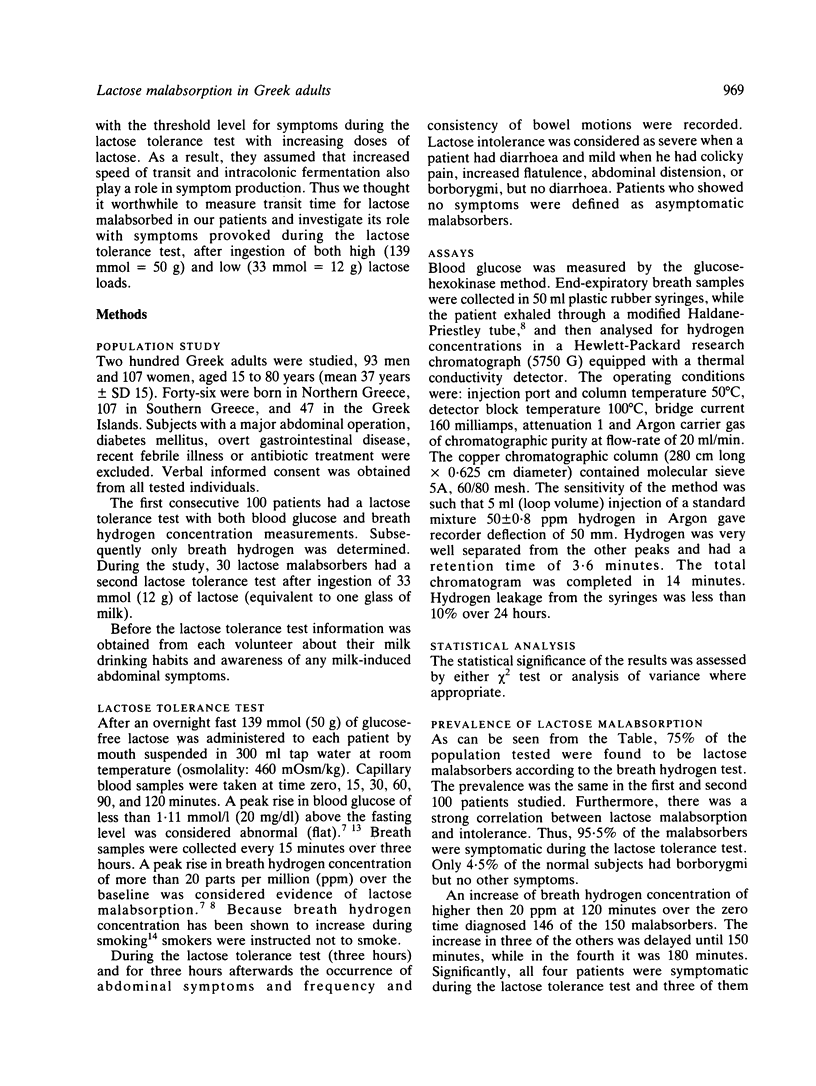
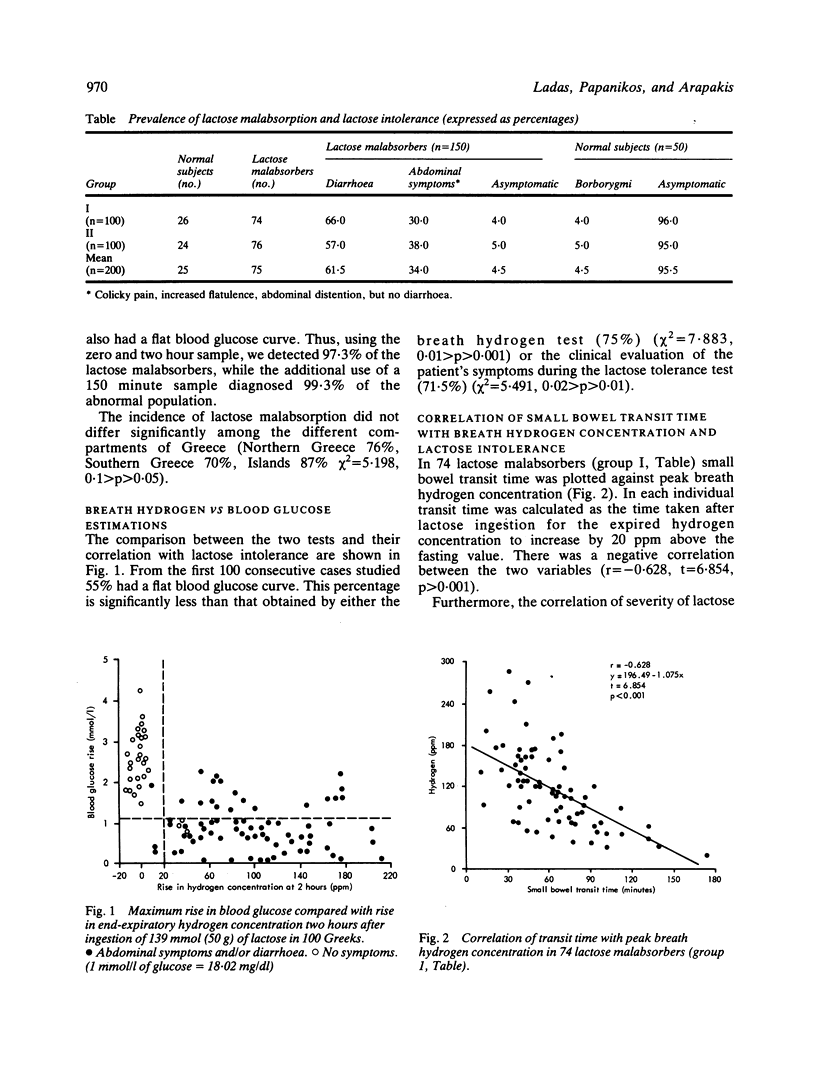
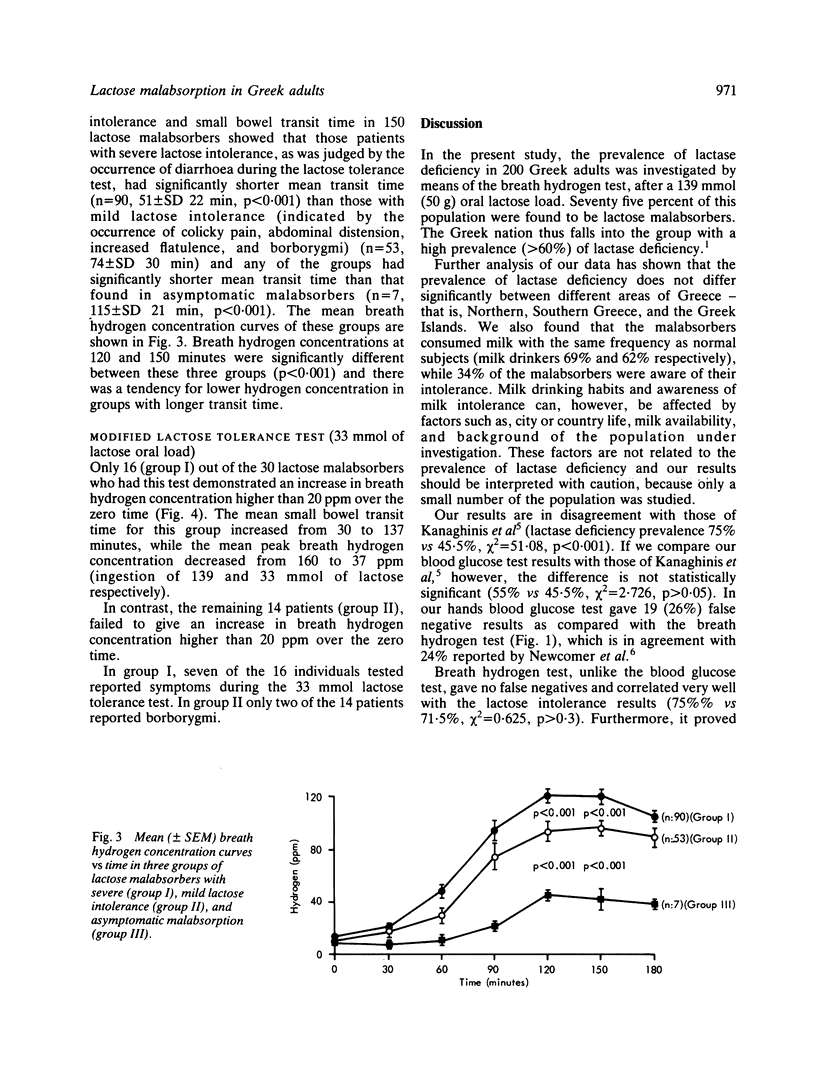
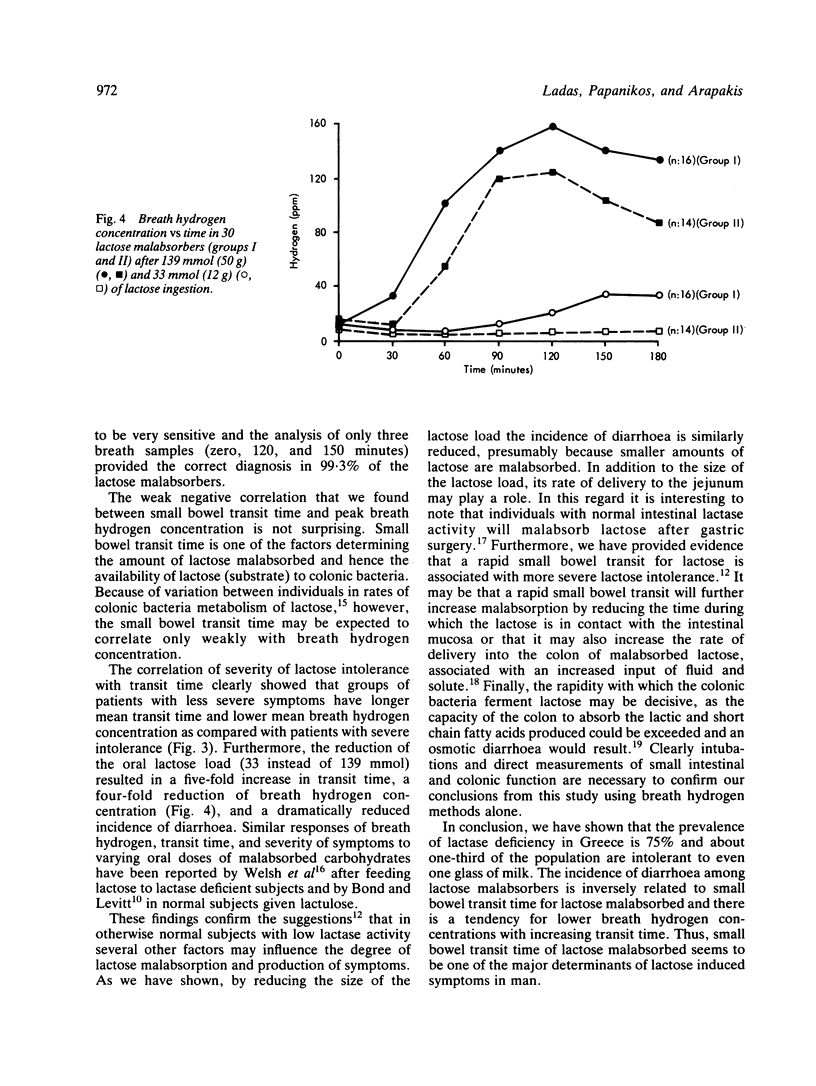
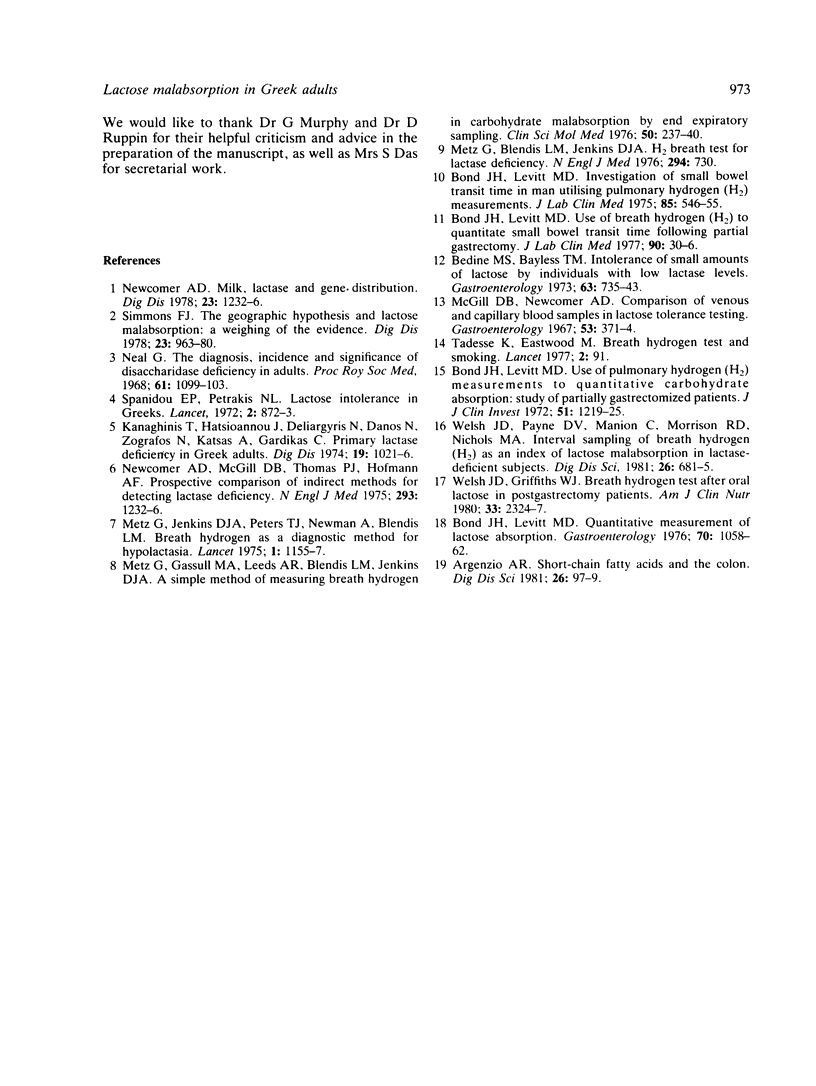
Selected References
These references are in PubMed. This may not be the complete list of references from this article.
- Argenzio R. A. Short-chain fatty acids and the colon. Dig Dis Sci. 1981 Feb;26(2):97–99. doi: 10.1007/BF01312223. [DOI] [PubMed] [Google Scholar]
- Bedine M. S., Bayless T. M. Intolerance of small amounts of lactose by individuals with low lactase levels. Gastroenterology. 1973 Nov;65(5):735–743. [PubMed] [Google Scholar]
- Bond J. H., Jr, Levitt M. D., Prentiss R. Investigation of small bowel transit time in man utilizing pulmonary hydrogen (H2) measurements. J Lab Clin Med. 1975 Apr;85(4):546–555. [PubMed] [Google Scholar]
- Bond J. H., Jr, Levitt M. D. Use of pulmonary hydrogen (H 2 ) measurements to quantitate carbohydrate absorption. Study of partially gastrectomized patients. J Clin Invest. 1972 May;51(5):1219–1225. doi: 10.1172/JCI106916. [DOI] [PMC free article] [PubMed] [Google Scholar]
- Bond J. H., Levitt M. D. Quantitative measurement of lactose absorption. Gastroenterology. 1976 Jun;70(6):1058–1062. [PubMed] [Google Scholar]
- Bond J. H., Levitt M. D. Use of breath hydrogen (H2) to quantitate small bowel transit time following partial gastrectomy. J Lab Clin Med. 1977 Jul;90(1):30–36. [PubMed] [Google Scholar]
- Kanaghinis T., Hatzioannou J., Deliargyris N., Danos N., Zografos N., Katsas A., Gardikas C. Primary lactase deficiency in Greek adults. Am J Dig Dis. 1974 Nov;19(11):1021–1027. doi: 10.1007/BF01255784. [DOI] [PubMed] [Google Scholar]
- McGill D. B., Newcomer A. D. Comparison of venous and capillary blood samples in lactose tolerance testing. Gastroenterology. 1967 Sep;53(3):371–374. [PubMed] [Google Scholar]
- Metz G., Blendis L. M., Jenkins D. J. Letter: H2 breath test for lactase deficiency. N Engl J Med. 1976 Mar 25;294(13):730–730. [PubMed] [Google Scholar]
- Metz G., Gassull M. A., Leeds A. R., Blendis L. M., Jenkins D. J. A simple method of measuring breath hydrogen in carbohydrate malabsorption by end-expiratory sampling. Clin Sci Mol Med. 1976 Mar;50(3):237–240. doi: 10.1042/cs0500237. [DOI] [PubMed] [Google Scholar]
- Metz G., Jenkins D. J., Peters T. J., Newman A., Blendis L. M. Breath hydrogen as a diagnostic method for hypolactasia. Lancet. 1975 May 24;1(7917):1155–1157. doi: 10.1016/s0140-6736(75)93135-9. [DOI] [PubMed] [Google Scholar]
- Newcomer A. D., McGill D. B., Thomas P. J., Hofmann A. F. Prospective comparison of indirect methods for detecting lactase deficiency. N Engl J Med. 1975 Dec 11;293(24):1232–1236. doi: 10.1056/NEJM197512112932405. [DOI] [PubMed] [Google Scholar]
- Simoons F. J. The geographic hypothesis and lactose malabsorption. A weighing of the evidence. Am J Dig Dis. 1978 Nov;23(11):963–980. doi: 10.1007/BF01263095. [DOI] [PubMed] [Google Scholar]
- Spanidou E. P., Petrakis N. L. Lactose intolerance in Greeks. Lancet. 1972 Oct 21;2(7782):872–873. doi: 10.1016/s0140-6736(72)92231-3. [DOI] [PubMed] [Google Scholar]
- Tadesse K., Eastwood M. Breath-hydrogen test and smoking. Lancet. 1977 Jul 9;2(8028):91–91. doi: 10.1016/s0140-6736(77)90098-8. [DOI] [PubMed] [Google Scholar]
- Welsh J. D., Griffiths W. J. Breath hydrogen test after oral lactose in postgastrectomy patients. Am J Clin Nutr. 1980 Nov;33(11):2324–2327. doi: 10.1093/ajcn/33.11.2324. [DOI] [PubMed] [Google Scholar]
- Welsh J. D., Payne D. L., Manion C., Morrison R. D., Nichols M. A. Interval sampling of breath hydrogen (H2) as an index of lactose malabsorption in lactase-deficient subjects. Dig Dis Sci. 1981 Aug;26(8):681–685. doi: 10.1007/BF01316855. [DOI] [PubMed] [Google Scholar]


